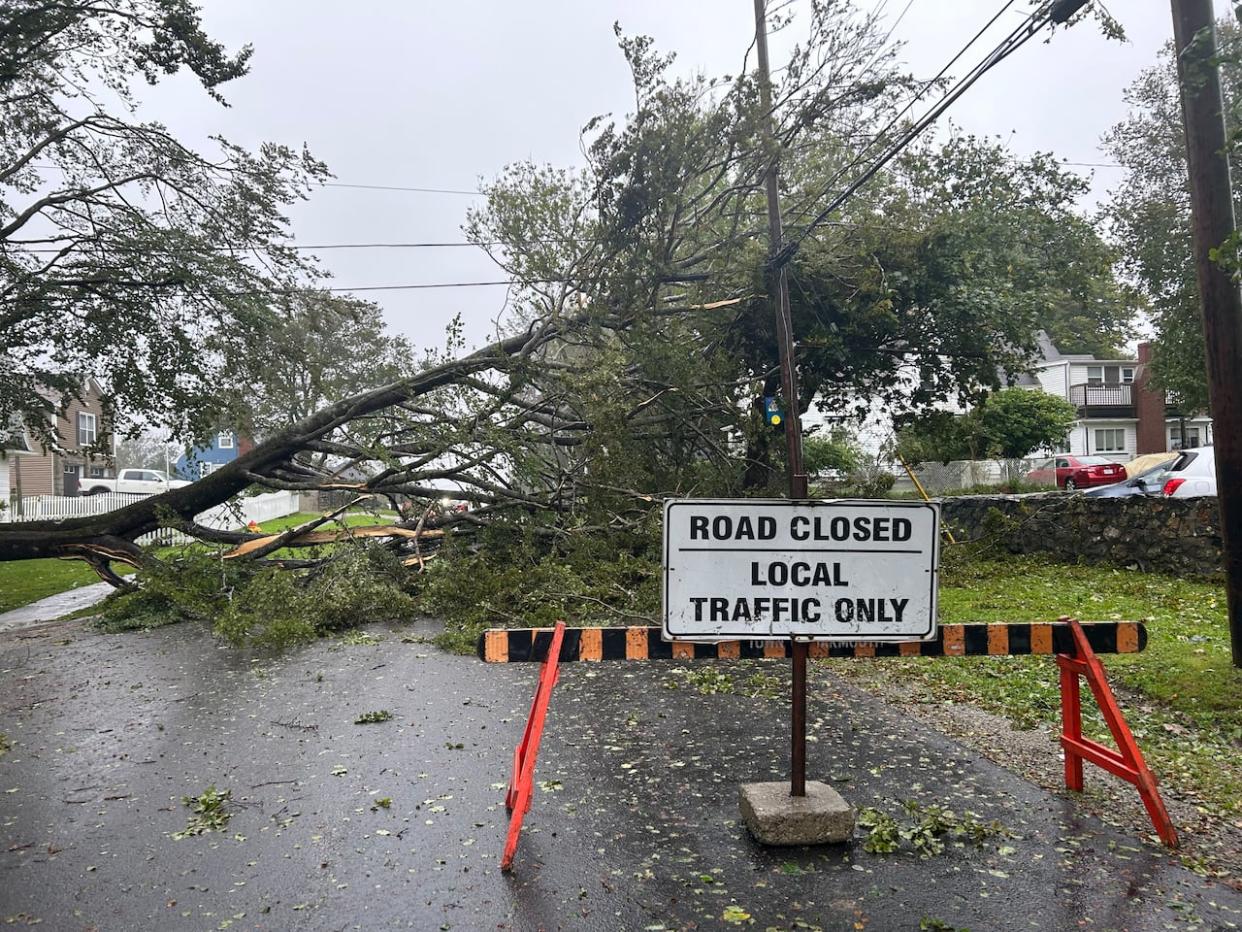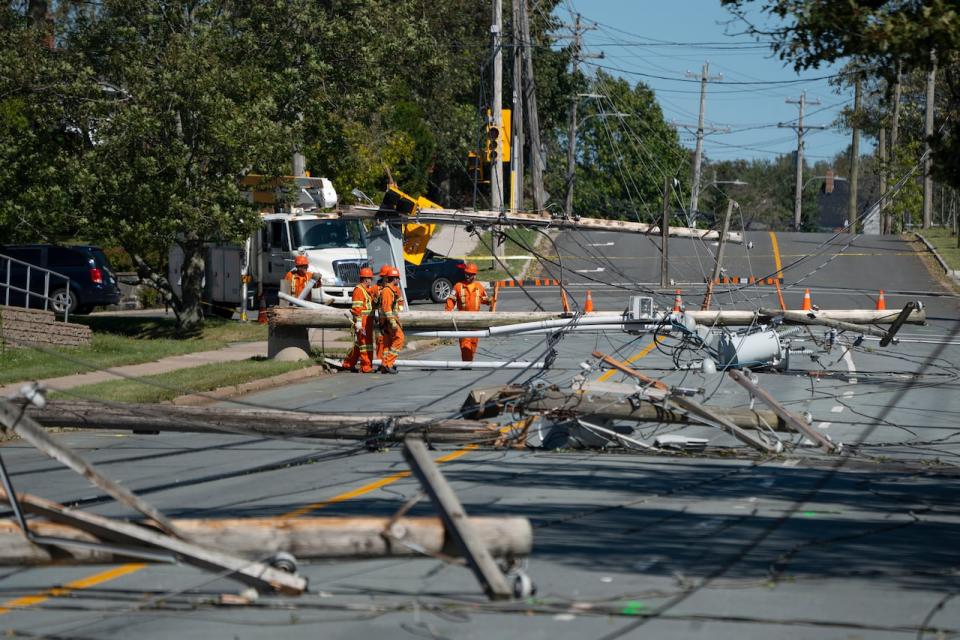Fewer phones on the blink last weekend after telecoms improved storm defences since Fiona

Telecommunications in Nova Scotia during the past weekend's storm appear to have been much less widely affected than during post-tropical storm Fiona, which swept across Atlantic Canada on Sept. 24 and 25 last year.
"I think we did very well," said Crissy Baillie, the senior director of field operations support for Eastlink. Baillie said there are some lines down and some structural damage, but Eastlink's "core network" didn't sustain any damage.
"So that was a step in the right direction."
Baillie said since Hurricane Fiona the company has added more fixed generators at its sites in Nova Scotia to keep cell towers running, and improved its "fuel management system."
"There was some challenges with Fiona getting fuel and getting it to where it needed to be," Baillie said. "So we improved that and we had even a backup to that with contractors that were enabled to be on call for additional fuelling."
Despite that, Baillie acknowledged there are still customers who were affected by Lee.
Rhonda Lantz, who lives in Oakland just outside Mahone Bay, N.S., said her home phone went out at the same time as her power on Saturday morning. It was restored on Thursday.

Damaged trees on top of phone lines caused outages that lasted 30 days for some residents on Nova Scotia's Eastern Shore following post-tropical storm Fiona. (Paul Palmeter/CBC)
"I have a cellphone, so I can call 911," she said, but added she's concerned about her neighbours who may not have cellphones.
All the telecom companies had representatives in the provincial command centre said John Lohr, the provincial minister for the Office of Emergency Management, on Thursday.
"It was very clear that they were taking it very seriously, so I'm pleased," Lohr said.
"They had made significant investments in generators and in hardening their own infrastructure. In some ways, Lee didn't really test that, but they have made significant progress."
Fiona vs. Lee
Following Fiona, all the major telecom companies filed documents with the CRTC describing what happened and how they fixed their networks.
Bell described how its network locations have about eight to ten hours of battery backup, and after that the sites switch to generator power.
"However, fuel [for the generators] is only capable of being pumped where there is power at gas stations and fuel depots," Bell wrote. "Replenishing generators with fuel was thus a challenge in locations where gas stations or diesel fuel depots were without power and where fuel could not be pumped."

Workers assess downed power poles caused by post-tropical storm Fiona in Dartmouth, N.S., on Sunday, Sept. 25, 2022. (Darren Calabrese/The Canadian Press)
Bell wrote that Fiona took out service to 193 "macro cell sites" due to power loss or network damage. A spokesperson confirmed Bell has more than 1,600 cell towers in Atlantic Canada.
Bell also estimated during Fiona it had about 4,079 landline customers in Nova Scotia who lost service by noon on Sept. 24.
Ahead of Lee, Bell said it spent $10 million to put 100 new fixed generators on "critical" cell towers across Atlantic Canada. It also installed 50 new fixed generators at wireline sites, with 100 more to come over the next two years.
In a statement, a spokesperson for Bell wrote that thanks to the backup systems "only 20 out of more than 1,000 cell towers in Nova Scotia and New Brunswick were without power on Saturday, and by Sunday evening all wireless sites were back online."
About 400 wireline cables were damaged but most have since been repaired.
In the Rogers filings with the CRTC, the company estimated 16,659 wireless customers in Nova Scotia had service outages longer than 24 hours during Fiona. It said 85 of its cell sites in Atlantic Canada were offline at the peak of the storm. As well, it said there were other sites that "withstood the storm but subsequently may have gone down due to power outages."
Rogers also said in addition to power outages, Fiona caused "serious physical damage" to its fibre network in Nova Scotia and Newfoundland.
A Rogers spokesperson said in a statement it brought in more than 100 mobile generators after Fiona.
Impacts during Lee were more limited, including power outages that caused service problems in East Port Medway, Wellington, Vaughan, Fletchers Lake, Lower Sackville, and Beaverdam Lake. Service was restored using portable generators.
Fiona's effects on hospitals and 911
According to Bell's filings, 13 hospitals or health-care facilities in N.S. and P.E.I. had service outages during Fiona that ranged in length from about two to 24 hours. The names and locations of the facilities are redacted in the filings.
"In all cases, we prioritized the recovery of service to these facilities as quickly as possible, typically dispatching service personnel as soon as it was safe to do so," Bell wrote to the CRTC.

Damaged infrastructure and power outages caused major problems for telecommunications during post-tropical storm Fiona. (Paul Palmeter/CBC)
Two 911 "public safety answering points" — call centres where 911 calls are routed — in Nova Scotia and one in P.E.I. were affected during Fiona.
In all cases, Bell said 911 calls were re-routed to a backup station and there was no time when the entire 911 network was down.
The first call centre in Nova Scotia lost four of its six operators due to a power loss on Sept. 24 that lasted about 3.5 hours. The second lost all its operators for about 8.5 hours early in the morning of Sept. 25.
A call centre on P.E.I. had a power loss and had to be taken off-line for about 3.5 hours on Sept. 25.
Rogers and Bell said there was no effect on 911 service for wireless customers during Lee.
MORE TOP STORIES


